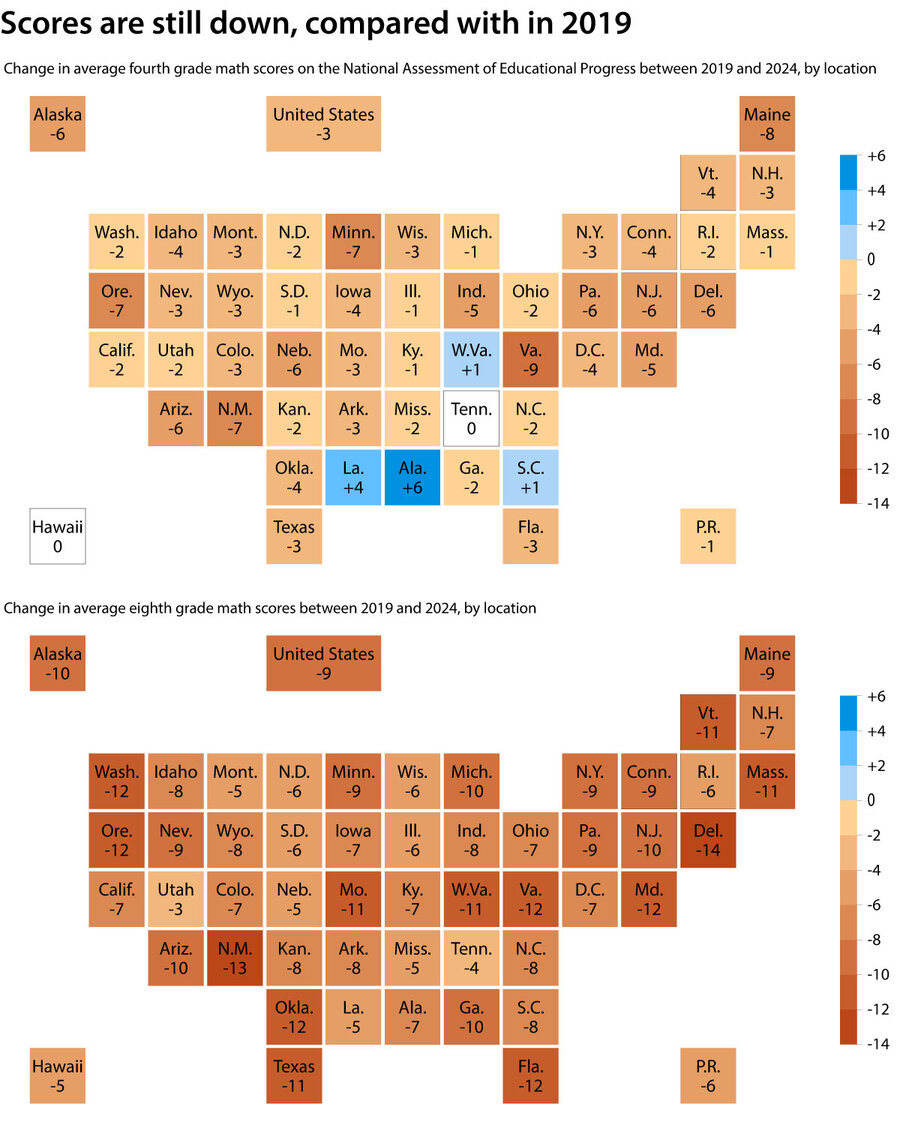‘The news is not good.’ Nation’s report card shows US students slipping further behind.
Loading...
America’s struggling students have fallen further behind in math and reading.
The latest results from the National Assessment of Educational Progress (NAEP), known as the “nation’s report card,” underscore the steep challenges that remain nearly five years after the pandemic disrupted learning for a generation of children. By and large, the results released Wednesday paint a grim portrait of academic recovery since the pandemic, especially in reading.
The lackluster outcomes are also sparking questions about what else may be hindering students from achieving their full academic potential. Chronic absenteeism, for example, continues to be a problem despite some improvements.
Why We Wrote This
Every two years, America’s schoolchildren get a report card on math and reading. The latest results show students falling further behind. But officials say it can’t all be blamed on the pandemic.
“The news is not good,” said Peggy Carr, commissioner of the National Center for Education Statistics, which administers the assessment. “Students who don’t come to school are not improving,” she added during a press conference Tuesday.
Every two years, a representative sampling of fourth graders and eighth graders in the United States takes the NAEP exam, which offers a snapshot of students’ math and reading progress. The new data stems from tests taken during the first quarter of 2024.
The average reading scores for fourth- and eighth-grade students fell by 2 points since 2022, continuing a decline that started before the pandemic. The lowest-performing students, in particular, struggle to comprehend reading. Students in the 10th and 25th percentiles are reading below levels recorded by students three decades ago.
Plus, a notably large share of students – 40% of fourth graders and 33% of eighth graders – is reading below the test’s basic level. That share of eighth graders is the largest recorded in the assessment’s history. Proficiency on the national exam means students have demonstrated competency over challenging subject matter, usually with a rigor that exceeds what most states consider grade-level achievement. A score in the basic level on NAEP signals partial mastery of fundamental skills or knowledge.
If the NAEP report contains any bright spots, it’s within mathematics. Fourth graders’ average math scores increased by 2 points since 2022. Fourteen school districts in large cities such as Los Angeles, New York, Atlanta, and Washington also saw fourth graders’ average math scores increase.
Results also stood out in Louisiana and Alabama, where fourth grade reading and fourth grade math showed statistically significant increases, respectively.
Raymond Hart, executive director of the Council of the Great City Schools, points to those gains as evidence of progress that districts can make, particularly with targeted funding.
“Sustaining our federal, state, and local investments [is] important to ensure that we can maintain those evidence-based practices and strategies that we saw were successful over the last few years,” he says.
The average math score for eighth graders did not significantly change – an outcome driven by a widening achievement gap between lower- and higher-performing students.
Meanwhile, 40% percent of fourth graders and 28% of eighth graders performed at a proficient or advanced level on the math tests. Those percentages reflect increases from 2022.
“We’ve made some progress, and for some states, significant progress. But it’s clearly going to take time, so I don’t think celebrating is what I see in these data,” Dr. Carr says. “Hope is what I see.”







